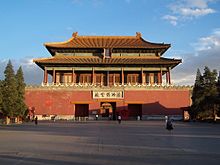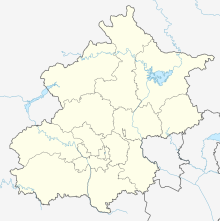
Back Verbode Stad Afrikaans المدينة المحرمة Arabic Ciudá Prohibida AST Yasaq şəhər Azerbaijani یاساق شهر AZB Забаронены горад Byelorussian Забранен град Bulgarian নিষিদ্ধ নগরী Bengali/Bangla Keoded difennet Breton Zabranjeni grad BS
 The Gate of Divine Might, the northern gate. The lower tablet reads "The Palace Museum" (故宫博物院) | |
| Established | 1925 |
|---|---|
| Location | 4 Jingshan Front St, Dongcheng, Beijing, China |
| Coordinates | 39°54′58″N 116°23′53″E / 39.915987°N 116.397925°E |
| Type | Art museum, Imperial Palace, Historic site |
| Visitors | 16.7 million[1] |
| Curator | Wang Xudong |
| Area | 72 hectares[2] |
| Built | 1406–1420 |
| Architect | Kuai Xiang |
| Architectural style(s) | Chinese architecture |
| Website | en www |
| Part of | Imperial Palaces of the Ming and Qing Dynasties in Beijing and Shenyang |
| Criteria | Cultural: i, ii, iii, iv |
| Reference | 439-001 |
| Inscription | 1987 (11th Session) |
| Forbidden City | |||||||||||||||||||||||
"Forbidden City" in Chinese characters | |||||||||||||||||||||||
| Chinese name | |||||||||||||||||||||||
|---|---|---|---|---|---|---|---|---|---|---|---|---|---|---|---|---|---|---|---|---|---|---|---|
| Chinese | 紫禁城 | ||||||||||||||||||||||
| Literal meaning | "Purple [North Star] Forbidden City" | ||||||||||||||||||||||
| |||||||||||||||||||||||
| Manchu name | |||||||||||||||||||||||
| Manchu script | ᡩᠠᠪᡴᡡᡵᡳ ᡩᠣᡵᡤᡳ ᡥᠣᡨᠣᠨ | ||||||||||||||||||||||
| Romanization | dabkūri dorgi hoton ‘Former inner city’ | ||||||||||||||||||||||
The Forbidden City, now known as the Palace Museum, is a large historical palace and an art museum in the historical center of Beijing, China. The site is a UNESCO World Heritage Site. It is very important to the history and architecture of China. The Forbidden City was the palace of the Emperor of China from the Ming Dynasty to the end of the Qing Dynasty. For almost 500 years, it was as the home of emperors and their houses, as well as the ceremonial and political center of Chinese government.
- ↑ 故宫2017年接待观众逾1699万人次 创历史新纪录 (in Chinese). 31 December 2017. Retrieved 24 March 2018.
- ↑ "The Layout of the Imperial Palace". 28 March 2019. Retrieved 30 March 2019.

